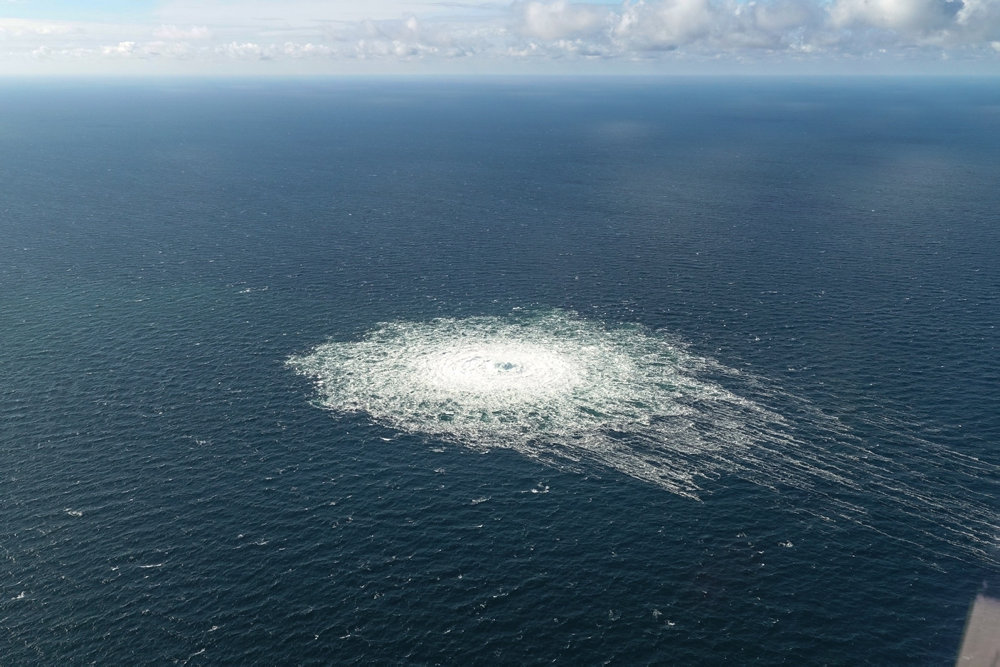Consequences of the Nord Stream 1 and 2 Gas Pipeline Explosions
On 26 September, the Nord Stream 1 (NS1) and Nord Stream 2 (NS2) gas pipelines exploded. The circumstances indicate that sabotage may have taken place. The incident could lead to a further escalation of tensions between Russia and the West. Regardless of who was the perpetrator, NATO and EU countries must strengthen their capacity to protect critical infrastructure.
 Danish Defense Ministry/Xinhua News Agency/Forum
Danish Defense Ministry/Xinhua News Agency/Forum
What happened?
Seismic stations in Sweden and on Danish Bornholm recorded explosions in international waters, in the Exclusive Economic Zones (EEZs) of Denmark and Sweden. According to these countries’ authorities, the incidents occurred on two lines of the NS 1 pipeline and one of the two lines of the NS2 pipeline; the state of the NS2’s second line is unclear. Neither pipeline was transporting gas to the EU at the time, as the NS2 certification process had been suspended by Germany following Russia’s full-scale invasion of Ukraine in February, and NS1 transmission was indefinitely halted by Gazprom in late August under the pretext of technical faults at a compressor station located in Russia. However, there was pressurised natural gas in the pipelines, which was what is called “technical gas” necessary for the eventual resumption of operations. The explosions led to leaks of this gas, which, if not stopped, could amount to about 117 million cubic metres in the case of the NS2 (according to the operator, there is no data on the filling status of NS1).
What are the risks stemming from possible sabotage?
The explosion occurred while Russia has been pressuring NATO and EU countries to limit their support for Ukraine. The incident may make it easier for Russia to use energy blackmail against European countries. Damage to NS1 will relieve Gazprom of its responsibility to resume the deliveries of supplies via this pipeline. A day after the damage to NS1 and NS2, Gazprom threatened to suspend gas transport to Central Europe via the pipeline through Ukrainian territory. The threats or their implementation may deepen the energy crisis in Europe. The attacks against critical infrastructure and Russian accusations that Western countries are responsible may also be used as a pretext for Russia to intensify its military activity in the Baltic Sea and to threaten military escalation against NATO. Thus, the incident gives the opportunity to influence the threat perception of NATO and EU countries, may facilitate their internal destabilisation, and divert attention from the situation in Ukraine where Russia conducted this week pseudo-referendums to annex the occupied territories.
What are the consequences of the incident for the environment and safety of navigation?
The leaks have resulted in a release of huge quantities of natural gas into the water and in turn, into the atmosphere. The gas consists mainly of methane, which is not toxic in the long-term to marine life, but its high concentration prevents normal respiration of marine organisms in the area of the incident and endangers their lives due to the possibility of an explosion. Furthermore, according to the Intergovernmental Panel on Climate Change, methane has 25 times the greenhouse effect potential of CO2. The head of the Danish energy agency estimates the potential emissions as equivalent to more than 30% of the annual emissions of Denmark. The leakage is therefore harmful to the climate. At the same time, it cannot be ruled out that Russia’s Gazprom could resume gas transmission to prolong the leakages and crisis. Potential methane explosions also threaten the safety of navigation and lower-altitude flights, so Danish and Swedish authorities have issued warnings to avoid the area.
Who can take action to stop the leaks and determine the causes?
Under the 1982 UN Convention on the Law of the Sea, the coastal state has jurisdiction in the EEZ with regard to the protection and preservation of the marine environment and has the right to adopt measures to control pollution from pipelines running through their EEZ. Denmark and Sweden can therefore take action themselves, but also demand that the operators of NS1 and 2—Gazprom’s subsidiaries Nord Stream AG and Nord Stream 2 AG—control the leaks. This follows from approvals granted by both countries for the construction of sections of NS1 and 2 in their EEZs, which made it explicitly conditional on these companies to respond to accidents during the operation of the pipelines.
The Convention does not regulate who should determine the circumstances of leaks. As they occurred in international waters, an investigation can be undertaken by any willing state or group of states, exercising their freedom of navigation. Investigations have already been undertaken by Denmark and Sweden, as well as by Russia and Germany, where NS 1 and 2 start and end. The EU and the U.S., among others, have announced their readiness to join the investigation. A combined Danish-Swedish investigation, with representatives of the parties involved (e.g., EU, U.S., and Russia) as observers deprived of the possibility to block the investigators’ activities, seems to be the optimal solution.
What conclusions should NATO, the EU, and Poland draw from the incident?
It again demonstrates the fundamental importance of the security of critical infrastructure at a time of escalating tensions between Russia and the Western countries. Attacks on infrastructure or the mere threat of them, constitute an inherent element of hybrid activities below the threshold of open conflict. The EU and NATO assume that such a threat will persist in the long term. For several years, both organisations have been strengthening their ability to detect hybrid threats, prevent them, or reduce their consequences, including as part of resilience measures. However, in practical terms, their cooperation is still very limited. The incident may be an opportunity to reach an agreement on maritime patrols necessary to oversee the security of critical infrastructure. Establishing a EU naval monitoring mission would make it difficult for Russia to use the incident as a pretext for military escalation against NATO. If it is proven that Russia was behind the attack on the pipelines, NATO and the EU should consider additional steps to strengthen their common ability to detect threats and protect infrastructure. Poland, which has been increasing its energy security through Baltic Sea infrastructure (LNG terminal in Świnoujście, Baltic Pipe, planned development of offshore wind farms and another LNG terminal, an FSRU type, in Gdańsk) could also conduct an analysis of the safety of the maritime critical infrastructure and its ability to protect it.



